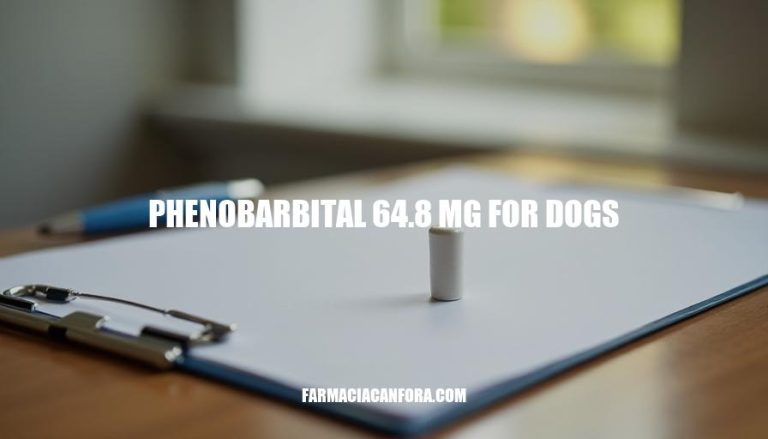


Phenobarbital is an important medicine for dogs with seizures. It helps control both kinds of seizures and improves their quality of life. By making sure the brain’s electrical activity stays stable, it’s often prescribed by veterinarians.
Phenobarbital works by helping a chemical in the brain called GABA do its job better, which reduces the chances of abnormal electrical activity that causes seizures.
Phenobarbital 64.8 mg is commonly used to manage seizure disorders in dogs. It is effective, safe when used responsibly, reasonably priced, and conveniently dosed.
Administration Frequency:
Phenobarbital is typically administered 2-3 times daily, with most dogs taking it twice daily. This schedule is convenient for most pet owners. If a dose is accidentally skipped, it should be given when remembered, and the subsequent dose should be administered at the appropriate time interval.
Phenobarbital can be given with or without food.
Dosage:
The dosage of phenobarbital varies depending on the dog’s weight and the frequency and severity of seizures. Generally, the starting dose is 2-4 mg/kg, administered twice daily. The dosage may be adjusted based on the dog’s response and serum phenobarbital levels.
Potential Side Effects:
Common side effects include sedation, polydipsia (increased thirst), polyphagia (increased appetite), and ataxia (lack of coordination). These side effects are usually temporary and resolve as the dog adjusts to the medication. Long-term side effects may include liver damage, which is the most dangerous side effect.
Monitoring liver function through regular blood tests is essential to detect any potential liver damage early. Other side effects may include frequent urination, excessive drinking and eating, and weight gain.
Precautions:
Liver Toxicity: Long-term use of phenobarbital can cause liver damage. Routine liver function tests are essential to monitor the dog’s liver health.
Withdrawal Risks: Phenobarbital should never be stopped suddenly, as abrupt cessation can lead to life-threatening seizures.
Drug Interactions: Phenobarbital can interact with other medications, including some antibiotics, corticosteroids, and other anticonvulsants.
It is crucial to inform the veterinarian of all medications the dog is taking.
Monitoring: Regular blood tests are important to monitor phenobarbital levels and liver function. This helps ensure the medication is working effectively and safely.
Storage: Phenobarbital should be stored at room temperature, away from light, and should not be refrigerated.
Phenobarbital is a valuable medication for managing seizures in dogs, but it requires careful monitoring and adherence to the prescribed dosage and administration schedule to ensure safe and effective treatment. Always consult with a veterinarian before starting or adjusting the dosage of phenobarbital for your dog.
:
:
:
:
Phenobarbital 64.8 mg is an effective medication for managing seizure disorders in dogs, helping to control both types of seizures and improve their quality of life.
It works by enhancing the activity of GABA, a chemical in the brain that reduces abnormal electrical activity causing seizures.
The dosage varies depending on the dog’s weight and severity of seizures, typically starting at 2-4 mg/kg administered twice daily. Regular blood tests are essential to monitor liver function and phenobarbital levels, as long-term use can cause liver damage.
Other potential side effects include sedation, increased thirst and appetite, and lack of coordination.
It is crucial to consult with a veterinarian before starting or adjusting the dosage of phenobarbital for your dog, as they will provide personalized treatment plans and monitor the medication’s effectiveness and safety. Additionally, inform your veterinarian about all medications your dog is taking to avoid potential drug interactions.